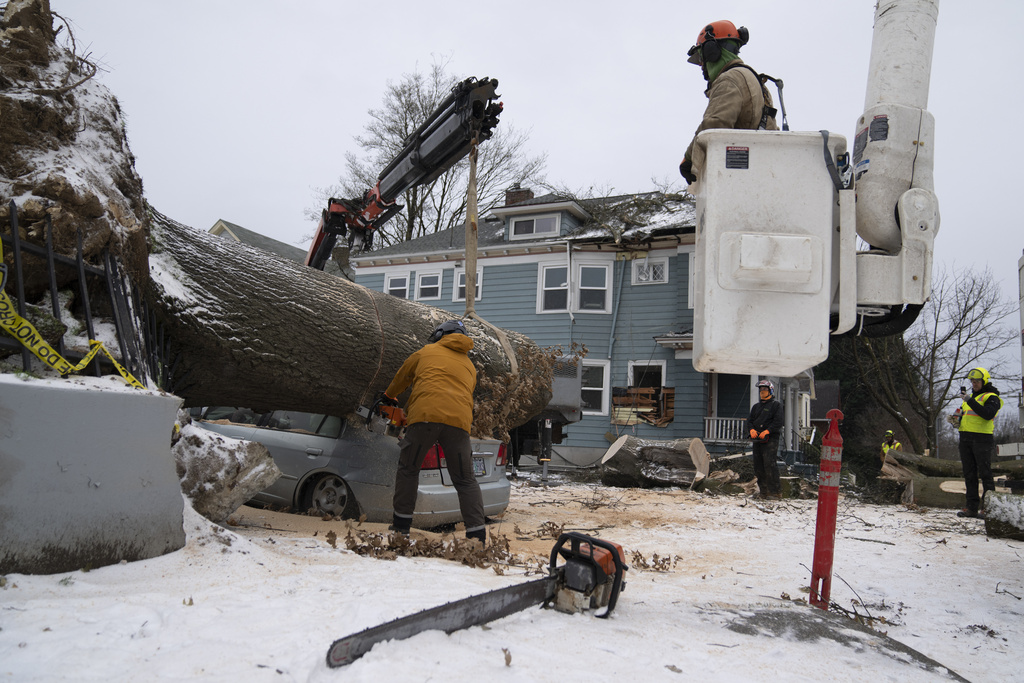This story was first published by Columbia Insight.
Snow and intense wind had just arrived in Portland on Jan. 13 when Matt Bonner heard a boom from his kitchen.
“It sounded like a bomb went off,” said Bonner.
A massive elm had toppled onto Bonner’s home, damaging his roof and his car and leaving him without water or power. The uprooted tree also blocked a thoroughfare in Portland’s Laurelhurst neighborhood.
This week, Bonner and his neighbor, James Puissegur, watched City of Portland arborists begin to remove the whale-sized elm 10 days after it fell.
There are more than 4 million trees in Portland, a city famous for its urban forest. The vast majority survived this month’s series of destructive storms that lasted more than a week.
Now, as the ice has finally thawed, residents and arborists across the city are taking stock of the damage.
In Portland, city bureaus have received more than 600 reports of downed trees, according to Mark Ross, public information officer at Portland Parks & Recreation.
About 30 roads, including Bonner’s street, remained closed as of Monday due to downed trees and drooping power lines as crews worked through maintenance backlogs.
Back-to-back storms—blizzard-like conditions and then freezing rain—caused the deaths of at least nine people in the Portland metro area. Three people were electrocuted when a falling branch knocked down a power line, and a Lake Oswego man was killed in his home by a large tree.
Why city trees take a beating
In Portland and around the state, winter storms brought a combination of gale-force winds and freezing rain.
According to Brittany Oxford, community assistance forester with the Oregon Department of Forestry, all types of trees fell: strong, weak, coniferous and deciduous.
Oxford theorized that trees in cities (including Eugene, where the storm destroyed 50 tress and damaged more than 1,000 others) fared worse than in genuine forestland because soil that’s typically compressed by roads, homes and driveways quickly becomes saturated with water, making trees unstable.
Plus, developers often remove tree roots during construction projects or cut down trees altogether. This makes surviving trees more susceptible to wind.
Experts aren’t sure whether climate change intensified the winter storm. But climate scientists say human-caused greenhouse gas emissions make severe weather events more common.
Van Bogner, an arborist with Pacific Standard Tree, said Oregon’s recurring drought might also shrink tree roots and make them less resilient in storms.
On Monday, Bogner and his crew chainsawed a downed pine on a private property in Southeast Portland’s Powellhurst-Gilbert neighborhood. The neighborhood was wracked with fallen tree trunks and branches; accessed by a closed road, a nearby stream surged with turbid water.
Down the block, Robert Pridgen’s family and home miraculously survived the storm.
Three mature conifers snapped like twigs on his next-door neighbor’s property and careened in different directions. One landed within feet of the room where his children were playing.
Pridgen was grateful. But he pointed up to his neighbor’s row of conifers that still loomed over his home.
“They still got like six more trees,” he said. “And they’re all pretty wavy in the wind.”
Monitoring Portland’s tree canopy
Portland Parks & Recreation monitors trends in Portland’s urban forest canopy cover using aerial photography.
The city’s tree canopy cover was measured in 2000, 2005, 2010, 2015 and 2020 in commercial, industrial, open space and residential zones.
According to a 2022 Parks & Recreation report, “From 2000 to 2020, statistically significant increases in tree canopy cover were found citywide and in commercial, industrial and residential zones.”
The report said increases over the 20-year period represented an addition of 2,289 acres of tree canopy. However, an overall tree canopy loss of 823 acres occurred between 2015–2020.
In residential zones, which make up the largest portion of the city’s land base, tree canopy increased from 14,345 acres to 16,351 acres between 2000-2015, but fell to 15,827 acres in 2020. Residential zones contain 57% of the city’s tree canopy.
The next measurement will be taken in 2025.
Benefits of urban tree canopies
Urban forests bring a slew of benefits, said Oxford of the Oregon Department of Forestry.
Trees capture carbon and reduce urban “heat islands” where they’re planted and cared for.
They also make rivers cleaner by filtering and reducing stormwater. Research links neighborhood tree cover to safer communities.
“A majority of trees in the city didn’t fall over and did survive the wind,” she said.
Wealthier neighborhoods tend to be more leafy in the United States. The federal government is doling out $58.2 million from the Inflation Reduction Act to address neighborhood tree cover inequities in Oregon. Idaho is receiving $5.72 million and Washington is receiving $36.37 million as part of the same program.
In context, recent damage to Portland’s tree canopy appears to have been moderate.
But “moderate” is a relative term, especially for those directly impacted.
This week in Northeast Portland, Bonner and Puissegur were still trying to figure out who owns the giant elm that dropped into Bonner’s home.
The tree stood on the street-side of the sidewalk, but Puissegur had consulted an insurance adjuster who wasn’t sure if the City of Portland owned it.
The arborists broke for lunch, and Bonner picked his way down a muddy lawn—his driveway was blocked by branches hundreds of feet long—to grimly take photos of sawed-off limbs.
The storm was over, but the recovery time will linger.
Oregon Capital Chronicle is part of States Newsroom, a network of news bureaus supported by grants and a coalition of donors as a 501c(3) public charity. Oregon Capital Chronicle maintains editorial independence. Contact Editor Lynne Terry for questions: info@oregoncapitalchronicle.com. Follow Oregon Capital Chronicle on Facebook and Twitter.



